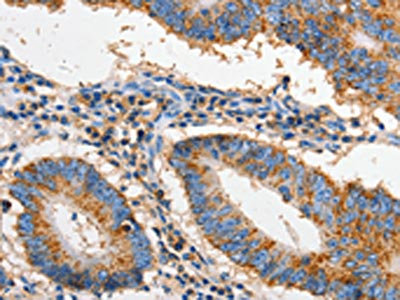
The image on the left is immunohistochemistry of paraffin-embedded Human colon cancer tissue using CSB-PA185779(FAS Antibody) at dilution 1/60, on the right is treated with fusion protein. (Original magnification: x200)
FAS Antibody

CSB-PA185779
ApplicationsWestern Blot, ELISA, ImmunoHistoChemistry
Product group Antibodies
ReactivityHuman
TargetFAS
Overview
- SupplierCusabio
- Product NameFAS Antibody
- Delivery Days Customer20
- ApplicationsWestern Blot, ELISA, ImmunoHistoChemistry
- CertificationResearch Use Only
- ClonalityPolyclonal
- ConjugateUnconjugated
- FormulationLiquid
- Gene ID355
- Target nameFAS
- Target descriptionFas cell surface death receptor
- Target synonymsALPS1A; APO-1; APO-1 cell surface antigen; apoptosis antigen 1; apoptosis signaling receptor FAS; apoptosis-mediating surface antigen FAS; APT1; CD95; CD95 antigen; Fas (TNF receptor superfamily, member 6); Fas AMA; FAS1; FASLG receptor; FASTM; mutant tumor necrosis receptor superfamily member 6; TNF receptor superfamily member 6; TNFRSF6; tumor necrosis factor receptor superfamily member 6; tumor necrosis factor receptor superfamily, member 6
- HostRabbit
- IsotypeIgG
- Protein IDP25445
- Protein NameTumor necrosis factor receptor superfamily member 6
- Scientific DescriptionThe protein encoded by this gene is a member of the TNF-receptor superfamily. This receptor contains a death domain. It has been shown to play a central role in the physiological regulation of programmed cell death, and has been implicated in the pathogenesis of various malignancies and diseases of the immune system. The interaction of this receptor with its ligand allows the formation of a death-inducing signaling complex that includes Fas-associated death domain protein (FADD), caspase 8, and caspase 10. The autoproteolytic processing of the caspases in the complex triggers a downstream caspase cascade, and leads to apoptosis. This receptor has been also shown to activate NF-kappaB, MAPK3/ERK1, and MAPK8/JNK, and is found to be involved in transducing the proliferating signals in normal diploid fibroblast and T cells. Several alternatively spliced transcript variants have been described, some of which are candidates for nonsense-mediated mRNA decay (NMD). The isoforms lacking the transmembrane domain may negatively regulate the apoptosis mediated by the full length isoform.
- ReactivityHuman
- Storage Instruction-20°C or -80°C
- UNSPSC12352203

